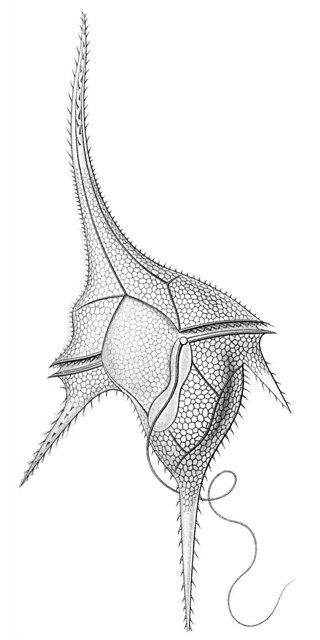
The dinoflagellates are a monophyletic group of single-celled eukaryotes constituting the phylum Dinoflagellata and are usually considered protists. Dinoflagellates are mostly marine plankton, but they are also common in freshwater habitats. Their populations vary with sea surface temperature, salinity, and depth. Many dinoflagellates are photosynthetic, but a large fraction of these are in fact mixotrophic, combining photosynthesis with ingestion of prey.

Dinokaryota is a main grouping of dinoflagellates. They include all species where the nucleus remains a dinokaryon throughout the entire cell cycle, which is typically dominated by the haploid stage. All the "typical" dinoflagellates, such as Peridinium and Gymnodinium, belong here. Others are more unusual, including some that are colonial, amoeboid, or parasitic. Symbiodinium contains the symbiotic zooxanthellae.
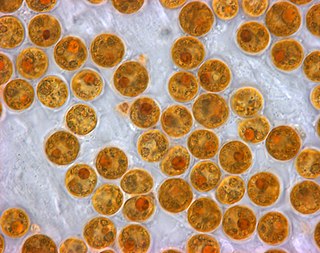
Zooxanthellae is a colloquial term for single-celled dinoflagellates that are able to live in symbiosis with diverse marine invertebrates including demosponges, corals, jellyfish, and nudibranchs. Most known zooxanthellae are in the genus Symbiodinium, but some are known from the genus Amphidinium, and other taxa, as yet unidentified, may have similar endosymbiont affinities. "Zooxanthella" was originally a genus name given in 1881 by Karl Brandt to Zooxanthella nutricula which has been placed in the Peridiniales. Another group of unicellular eukaryotes that partake in similar endosymbiotic relationships in both marine and freshwater habitats are green algae zoochlorellae.

The aggregating anemone, or clonal anemone, is the most abundant species of sea anemone found on rocky, tide swept shores along the Pacific coast of North America. This cnidarian hosts endosymbiotic algae called zooxanthellae that contribute substantially to primary productivity in the intertidal zone. The aggregating anemone has become a model organism for the study of temperate cnidarian-algal symbioses. They are most well known for the ability to clone themselves.

The staghorn coral is a branching, stony coral, within the Order Scleractinia. It is characterized by thick, upright branches which can grow in excess of 2 meters (6.5 ft) in height and resemble the antlers of a stag, hence the name, Staghorn. It grows within various areas of a reef but is most commonly found within shallow fore and back reefs, as well as patch reefs, where water depths rarely exceed 20 meters (65 ft). Staghorn corals can exhibit very fast growth, adding up to 5 cm in new skeleton for every 1 cm of existing skeleton each year, making them one of the fastest growing fringe coral species in the Western Atlantic. Due to this fast growth, Acropora cervicornis, serve as one of the most important reef building corals, functioning as marine nurseries for juvenile fish, buffer zones for erosion and storms, and center points of biodiversity in the Western Atlantic.

Convolutidae is a family of acoels, belonging to the phylum Xenacoelomorpha. This family contains more than a third of all known acoel species.
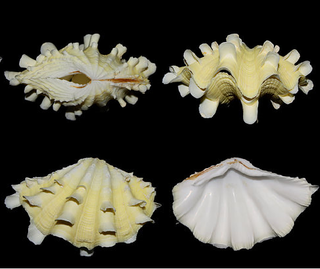
Tridacna squamosa, known commonly as the fluted giant clam and scaly clam, is a species of bivalve in the family Cardiidae.

Symbiodinium is a genus of dinoflagellates that encompasses the largest and most prevalent group of endosymbiotic dinoflagellates known and have photosymbiotic relationships with many species. These unicellular microalgae commonly reside in the endoderm of tropical cnidarians such as corals, sea anemones, and jellyfish, where the products of their photosynthetic processing are exchanged in the host for inorganic molecules. They are also harbored by various species of demosponges, flatworms, mollusks such as the giant clams, foraminifera (soritids), and some ciliates. Generally, these dinoflagellates enter the host cell through phagocytosis, persist as intracellular symbionts, reproduce, and disperse to the environment. The exception is in most mollusks, where these symbionts are intercellular. Cnidarians that are associated with Symbiodinium occur mostly in warm oligotrophic (nutrient-poor), marine environments where they are often the dominant constituents of benthic communities. These dinoflagellates are therefore among the most abundant eukaryotic microbes found in coral reef ecosystems.

The spotted jelly, lagoon jelly, golden medusa, or Papuan jellyfish, is a species of jellyfish from the Indo-Pacific oceans. Like corals, sea anemones, and other sea jellies, it belongs to the phylum Cnidaria. Mastigias papua is one of the numerous marine animals living in symbiosis with zooxanthellae, a photosynthetic alga.

Hippopus hippopus, also known as the Horse Hoof clam and Strawberry clam, is a species of giant clam in the Subfamily Tridacninae and the genus Hippopus. Hippopus is a delicacy in many Southeast Asian countries due to its high quality meat.

Cassiopea andromeda is one of many cnidarian species called the upside-down jellyfish. It usually lives in intertidal sand or mudflats, shallow lagoons, and around mangroves. This jellyfish, often mistaken for a sea anemone, usually keeps its mouth facing upward. Its yellow-brown bell, which has white or pale streaks and spots, pulsates to run water through its arms for respiration and to gather food.
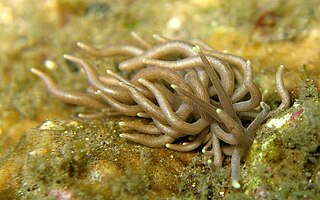
Phyllodesmium is a genus of predatory sea slugs, aeolid nudibranchs, marine gastropod molluscs in the family Myrrhinidae.

Corculum cardissa, the heart cockle, is a species of marine bivalve mollusc in the family Cardiidae. It is found in the Indo-Pacific region. It has a symbiotic relationship with dinoflagellates (zooxanthellae), which live within its tissues.

Antillogorgia bipinnata, the bipinnate sea plume, is a species of colonial soft coral, a sea fan in the family Gorgoniidae. It is found in the Caribbean Sea. It was first described as Pseudopterogorgia bipinnata in 1864 by the American zoologist Addison Emery Verrill. Williams and Chen (2012), transferred all the Atlantic species of Pseudopterogorgia to Antillogorgia.

Anthopleura ballii, commonly known as the red speckled anemone, is a species of sea anemone in the family Actiniidae. It is found in shallow water in the northeastern Atlantic Ocean.
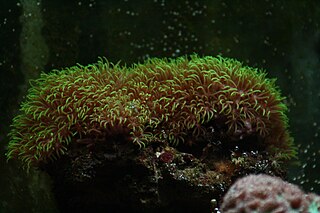
Clavularia viridis is a species of colonial soft coral in the family Clavulariidae. It is found in shallow waters in the tropical Indo-Pacific.
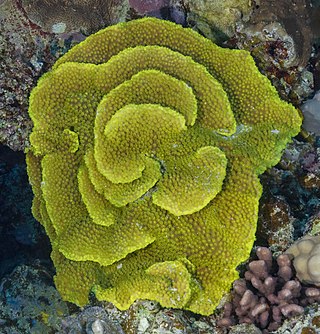
Turbinaria reniformis, commonly known as yellow scroll coral, is a species of colonial stony coral in the family Dendrophylliidae. It is native to the Indo-Pacific region. The International Union for Conservation of Nature has rated its conservation status as being "vulnerable".
Waminoa brickneri is a species of acoel from the coral reefs around the northern Red Sea and the second described species in the genus.
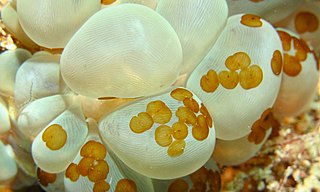
Waminoa is a genus of acoels which are epizoic on living corals, using the coral's mucus as a source of food. Unusually, these acoels harbor two genera of endosymbiotic dinoflagellates: Symbiodinium and Amphidinium; it is not typical for two different genera of dinoflagellates to coexist in a single host. Waminoa's host coral may also contain dinoflagellates of the genus Symbiodinium but not Amphidinium.
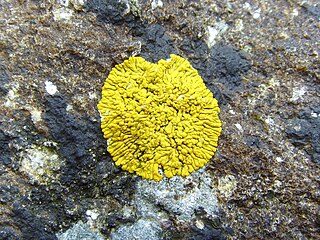
Photosymbiosis is a type of symbiosis where one of the organisms is capable of photosynthesis.


















